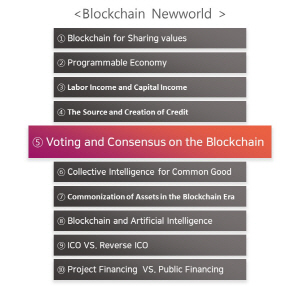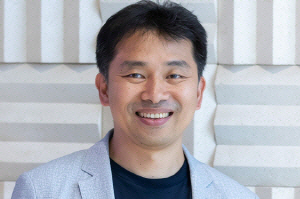


In the last article, I talked about the sourcing and creation of decentralized credit (CREDIT CREATION, FROM BANKS TO BLOCKCHAIN) that blockchain is pursuing. In this article, I will talk about the methods of voting and finding consensus in a blockchain community.
In Korea, multiple blockchain-related conferences are held every month. There are numerous conferences around the world where people gather to share various perspectives, opinions and information on latest technologies and economy. One of the most famous blockchain conferences is “Consensus” which is held in New York every year. Choosing “Consensus” as the name of the event, instead of words like blockchain or cryptocurrency, was brilliant, as it shows exactly what we need to focus on in the blockchain economy.
As I mentioned in my second article, the blockchain community is an “economic community (Blockchain Led Programmable Economy)” that functions based on consensus algorithms without any human intervention. In the actual execution phase, it is automated and executed by algorithms.
But these algorithms need to be adopted through a consensus process. A fork happens when no consensus is reached. A hard fork in blockchain occurs when there‘s a disagreement in the community. Ethereum classic and Ethereum are one such example. They split and became two separate communities that use different blocks and coins.
If a community implements a hard fork whenever they disagree, it will be a serious problem affecting the sustainability of the blockchain community. Conversely, if it is too hard to implement a hard fork when a split is necessary, it will become an obstacle that prevents the advancement of technology.
Thus, for the smooth operations of the community algorithms, governance is required. Most communities adopted a traditional democratic voting system.
But how to vote depends on each community and the algorithms they use. The important thing is that the management principles of how to reach consensus is there as a concept of governance under consensus.
For example, the EOS community is using “shareholder democracy” as a governance system to reach consensus for important issues. The more shares you own, the greater influence you have. EOS’s governance system is a good way to stick to the operating principles that the majority believes, but it has a potential problem in the long term that a few people with more shares may be able to hold sway over decision-making.
Another consensus method is a direct democracy that uses the principle of one-person, one-vote.
We all have one vote regardless of how much share we have, and we follow the rational decisions made by the majority of the community. In that regards, the one-person, one-vote system is the closest to the PoW (Proof of Work) which is the most commonly used decentralized method to reach consensus. One shortcoming is the decreasing number of voting participants, and many methods have been suggested to complement this. The doctrine of one-person one-vote is related with collective intelligence which I will go over in more detail in the next article.
In this article, I will just briefly discuss how to implement a one-person, one-vote system in a technology point of view.
Four principles of elections as we learned from school are general, secret, equal and direct elections. Keeping these principles in an online election is not as simple as an offline election where you can just go to a voting booth with a photo ID. A hacker may use some trickery to vote multiple times under different names. That‘s why special technology is needed to prove that one person had one vote. However, secret ballots should be guaranteed as well so that the identities of the voters are not exposed. There should be a way to know that the person who is voting now is a different person from who just voted while the anonymity of the voters’ ballots is protected. So, the governance in blockchain remains a very difficult technological issue to solve.
For example, the 4th generational encryption technology such as homomorphic encryption is one of the technologies outside blockchain that may help implement governance in blockchain. Combined with blockchain, technologies like that will drive the growth of blockchain. Homomorphic encryption allows operations to be performed on encrypted data without compromising the encryption. This technology will work great for electronic voting for governments.
A lot of technologies and technological convergence are required to implement the bold philosophy of blockchain. In this article, I explained about consensus in blockchain and the governance system that manages consensus. Also I talked about that we need a lot of technological convergence to implement the concepts of consensus and governance. In the next article, I‘m going to talk about the power of collective intelligence in a blockchain community that adopted a direct democracy where the one-person, one-vote concept applies. /Yezune Choi BOSCoin CEO
- Yezune Choi BOSCoin CEO








![비트코인 8만 8000달러선…주요 알트코인도 하락세[디센터 시황]](https://newsimg.sedaily.com/2025/12/15/2H1QMJVFUE_2_s.png)




![[단독]네이버파이낸셜, 해시드와 ‘코인 지갑’ 내달 선보인다](https://newsimg.sedaily.com/2025/11/25/2H0LB3A07Q_11_s.jpg)
![[단독]금융위 “공동검사 요구 과도”…스테이블코인 놓고 한은과 파열음](https://newsimg.sedaily.com/2025/11/24/2H0KUTU6OA_5_s.png)
![[단독] '은둔의 경영자' 송치형, 네이버와 합병 청사진 직접 밝힌다](https://newsimg.sedaily.com/2025/11/21/2H0JI570IZ_5_s.jpeg)







